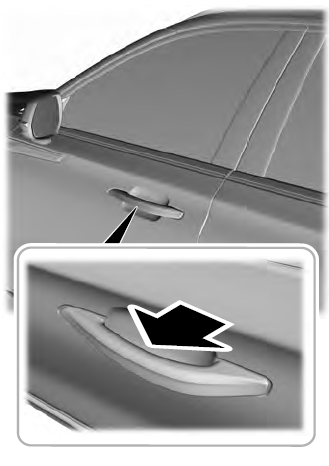Lincoln Aviator 2020-2025 Service Manual / Powertrain / Engine / Fuel Charging and Controls - 3.0L EcoBoost/3.0L EcoBoost – Hybrid (BQ) / Removal and Installation - High-Pressure Fuel Pump Drive Unit
Lincoln Aviator: Fuel Charging and Controls - 3.0L EcoBoost/3.0L EcoBoost – Hybrid (BQ) / Removal and Installation - High-Pressure Fuel Pump Drive Unit
Removal and Installation
-
The high-pressure fuel pump drive unit is part of the
right cylinder head and is removed in the right camshaft procedure.
Refer to: Cylinder Head RH (303-01A Engine - 3.0L EcoBoost, Removal and Installation).
Refer to: Camshaft RH (303-01A Engine - 3.0L EcoBoost, Removal and Installation).
 Removal and Installation - High-Pressure Fuel Pump
Removal and Installation - High-Pressure Fuel Pump
Removal
NOTICE:
Do not loosen any fittings or plugs on the high-pressure fuel pump.
With the vehicle in NEUTRAL, position it on a hoist.
Refer to: Jacking and Lifting (100-02 Jacking and Lifting, Description and Operation)...
 Removal and Installation - Throttle Body
Removal and Installation - Throttle Body
Removal
NOTICE:
The turbocharger compressor vanes can be damaged by even the
smallest particles. When removing any turbocharger or engine air intake
system component, ensure that no debris enters the system...
Other information:
Lincoln Aviator 2020-2025 Service Manual: Specifications
Lubricants, Fluids, Sealers and Adhesives NOTE: Per the warranty and policy manual the Ford Engineering-approved refrigerant (see table for service part number) must be used for air conditioning repairs Item Specifications Motorcraft® R-1234yf Refrigerant POE Oil / YN-34 (US, Canada) WSS-M2C31-B2 Motorcraft® R-1234yf Refrigerant PAG Oil / YN-35 (US, Canada) WSS-M2C300-A2 Motorcraft® Electric A/C Compressor Oil / YN-32 (Mexico, Asia Pacific) _ Motorcraft® PAG Refrigerant Compressor Oil / YN-12-D (Mexico, Asia Pacific) WSH-M1C231-B R-1234yf Refrigerant / YN-33-A (US); HS7Z-19B519-BA (Canada) WSS-M17B21-A Motorcraft® R-134a Refrigerant / MYN-19 (Mexico, Asia Pacific) WSH-M17B19-A Motorcraft® A/C System Flushing Solvent / YN-23 _ Motorcraft® A/C Cooling Coil Coating / YN-29 _ Capacities Item Specifications Motorcraft® R-1234yf Refrigerant PAG Oil / YN-35 (US, Canada) 3...
Lincoln Aviator 2020-2025 Service Manual: Removal and Installation - Radiator Grille Opening Panel
Removal NOTE: Removal steps in this procedure may contain installation details. Remove both the headlamps. Refer to: Headlamp Assembly (417-01 Exterior Lighting, Removal and Installation). Remove the Horn assembly. Refer to: Horn (413-06 Horn, Removal and Installation)...
Categories
- Manuals Home
- Lincoln Aviator Owners Manual
- Lincoln Aviator Service Manual
- Body and Paint
- Fuel Quality
- Changing the Front Wiper Blades - Vehicles With: Heated Wiper Blades
- New on site
- Most important about car
Activating Intelligent Access
The intelligent access key must be within 3 ft (1 m) of the door or luggage compartment you intend to lock or unlock.
At a Door
Electronic door handles are on each door. Gently depress the switch inside the exterior door handle to unlock and open the door. An unlock symbol illuminates on the door window trim indicating your vehicle is unlocked.

Copyright © 2025 www.liaviator2.com
